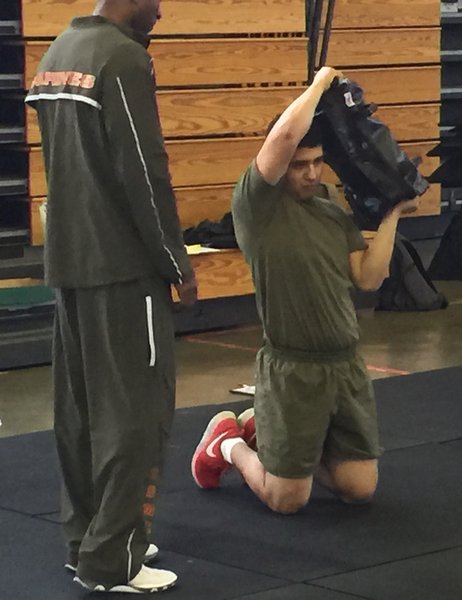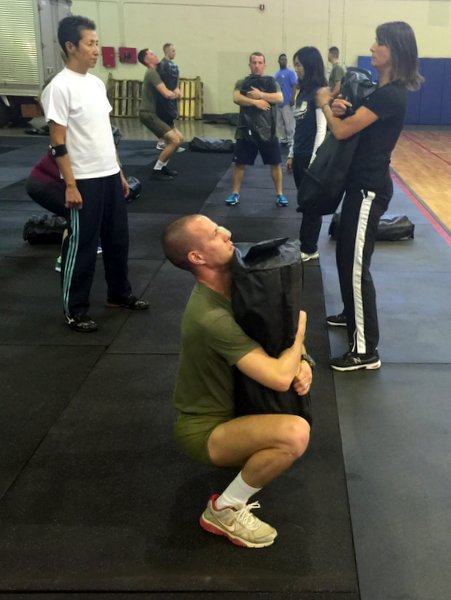To help you develop better programs, I will share some of the common pitfalls.
The Ex-Athlete
During the first NSCA TSAC conference, I spoke with a SWAT operator from New York. I asked him what he thought of the presentations and he simply said, "You can tell who is an operator and who is not." Did he mean that you must have experience as an officer, fire fighter, or the military to create an impactful program? Absolutely not!
He meant that it was easy to see the difference between people who really understood the needs and demands of the job—versus those who wanted to show "cool" looking "tactical" exercises that didn’t really match what was needed.
Saying you must have experience in these various services is like saying you have to have played basketball, football, or baseball in order to coach. In reality, many of the best coaches in these sports have very little playing background. But, what they lack in experience, they make up for by dedicating themselves to knowing what must be done to perform the job at a high level.

If you want to work with any of these departments, learn as much about them as possible. What are they already doing for training, what are the most common issues they face, what do THEY perceive to be obstacles, and what are limitations in their programs. Remember the old saying, we have two ears and one mouth for a reason!
I have been very fortunate, in the last ten years I have been able to develop programs for fire departments, SWAT programs, US Army, and consult with the US Marines. I can tell you one thing, they are all VERY different. Just like you wouldn’t train a basketball and football player the same way, you need to know the needs and issues of the department you’re wanting to train.
The worst thing you can do is pretend to be something you are not. Just as the ex-sports athlete isn’t always a great coach (Michael Jordan was a terrible coach!), not all former operators are good at fitness programming. Your job is to be the best at creating applicable programs based on fitness science and the information you are able to collect!
The Best Ability
We often think that ONE ability or quality that makes someone the best they can be. Is it strength, speed, endurance? The best answer I’ve heard to this common question was from football analyst, Todd McShay. While debating what makes the best football player, McShay stated, "The best ability is availability". That sounds like one giant, DUH, statement, but it carries so much simple truth.
If you are so consumed with strength, power, and/or endurance that you end up becoming injured, then you can’t help anyone. When it comes to tactical programs this is crucial! The number one reason I am brought into various departments wasn’t to make people bigger, stronger, faster, or "more fit". Time and time again, they wanted me to help reduce injuries. And, as Todd McShay said, if a member of the team isn’t available it puts, EVERYONE at a serious disadvantage.
A future article will discuss the type of training we actually do, but these programs are now including the
Functional Movement Screen,
Dynamic Variable Resistance Training, and
Hardstyle kettlebell training, to keep operators available and healthy. Implementing easy ways to evaluate the risk of injury, and sharing statistics on how you can reduce injuries will improve your ability to significantly help these departments.
Awareness of how much is demanded of these men and women will help you understand that the LAST thing they need is to be beaten up further!
 You Aren’t As Tough As You Think
You Aren’t As Tough As You Think
Possibly the number one mistake of the fitness professional is to think that they must prove their toughness by creating ridiculously difficult workouts. You will not earn a department’s respect by destroying them in the gym!
First of all, your workout probably isn’t the hardest or toughest thing they have ever done. I have been fortunate—I suggest you try to do the same—to witness the skill training SWAT teams, fire departments, and various military programs do. Guess what, your workouts aren’t the hardest training. Hours and hours of training in incredibly uncomfortable situations is way more challenging than your 30 minute or hour long session, I don’t care how crazy the training.
One of the best compliments I ever received was from an older Marine while I was running one of our
DVRT and HKC programs in Okinawa a few weeks ago. He told me the way we taught was very different than how Marines are accustomed to being instructed. I asked if that was a good thing, and he went on to say, "VERY"! Because we explained why they were doing what they were doing, it was easier for them to buy into the program. Many times they have been told what to do and were expected to follow orders. It was really great for them to learn WHY they were doing specific activities.
You will accomplish much more by setting operators up for success, instead of trying to drive them into the ground. A good program based on solid principles and progressions will be much more successful than trying to demonstrate any type of toughness. Taking the time to inform and teach is far more effective than barking and yelling.
Sometimes we forget that even though these men and women do incredibly demanding jobs, they are still people. As the saying goes, "success breeds success", and the job of a coach is to place people in the position to experience such success.
This article wasn’t about specific training techniques, I’m saving that topic for an upcoming article. However, I think it is important to establish the philosophy of our training for the tactical athlete. Once you understand why we focus on some aspects over others, the ideas and programming will make much more sense. I hope that if you are planning to work with your local fire or police departments, or the military, you will remember this article and truly make a difference in your community and these incredible men and women!